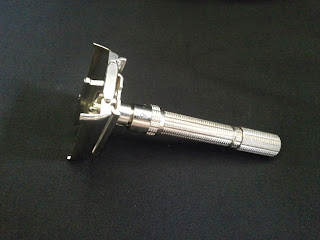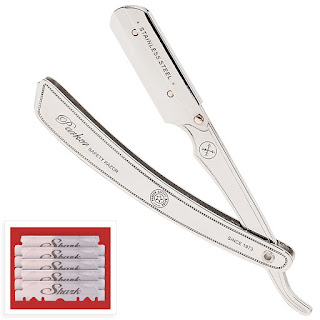If you haven't guessed based on my announced up-coming shaving "garage" sale, I do like the Parker Variant razor (a lot). But describing it to you becomes a delicate balance of forbearance and effusion -- a risky balance like walking a tightrope or climbing a razor-thin ridge on your way to a snow-encrusted mountain peak.
 |
| My Variant razor by Parker. |
USPS Delivers.... Disappointment
My Variant tale begins with a balancing act between impatience and excitement as well as expectation and anger. I placed my order with supersafetyrazors.com, and they shipped the Variant promptly (great!) via 1st-class USPS. Then I got the shipment-tracking info from the postal service and watched the sporadic progress of my new "baby," anticipating delivery on the USPS-predicted delivery date. Long story short, the USPS always delivers -- but too often they deliver
disappointment. Watching their package-tracking progress is like watching your favorite football team get repeatedly hosed by bad refereeing (and we Detroit Lions fans know a lot about that one!).
The parcel arrives at a given transfer center and... sits. Then it's listed as shipped on to the next stop... but wait... hours later it's listed again as
just shipping out to the next stop. AAARRRRGGGGHHHH! (What the Hell is going on?) Then it gets to the final transfer point and -- you guessed it -- it sits. It boggles my mind how the USPS predicts a delivery day thereby getting my expectations up (after all,
they told me the predicted delivery day), and then that day comes and goes with no delivery. AAARRRGGGGHHHH!
Initial Concerns
So the razor arrives -- finally! As you might expect, I dove into the package as soon as possible and began
my normal, careful safety inspection of the razor. I detect what seems to be a subtle, easily-overlooked misalignment of the blade edge to the safety bar. Hmmm. I double check. My excitement is taking a misstep off that mountain ridge and is in danger of sliding into the abyss of despair.
After all, if such a misalignment is real, it
could result in harsh shaves -- or worse. So I called supersafetyrazors.com to discuss my concern and ended up talking to the head honcho -- not only for supersafetyrazors.com, but for, in effect, Parker USA. (Supersafetyrazors.com puts a business card in their shipments for convenient customer contact.) He was very forthcoming, very helpful, emphasized his company's focus on
complete customer satisfaction. He shipped out a replacement razor
that day including a mailer for the free-and-easy return of the questionable razor.
He explained that he and the Parker mother ship in India (my description, not his) were
extremely focused on quality, complete customer satisfaction and getting the launch of this new razor as right as possible (and I believe him). He said that there have been a few issues and a learning curve, but they are leaving no stone unturned to get this product right, now and in the future.
So to return to the narrative: he shipped my replacement razor AND THE USPS DID IT AGAIN! AAARRRRGGGGHHHH! (Why can't the USPS under promise, leave some room for delay, lower customer expectations and then if they deliver the package sooner, the customer is delighted? There is something
seriously wrong with the USPS management -- just my opinion.)
Replacement Razor Arrives
Okay, the razor
finally arrives and I dive in again. But, wait a minute.... this one seems to have the same alignment issue based on eyeball inspection. Now I'm really concerned and get back on the phone to supersafetyrazors.com, who are once again super supportive, open, forthright and reassuring. Seriously.
Based on
that conversation, I decide to give my replacement Variant a cautious trial shave. I actually put in a blade that I don't like very much, a Derby Extra that I'd had lying around forever. (I don't know exactly why I chose that blade; perhaps it had something to do with Mantic59 saying it worked well for him in his Merkur Progress.)
Joy
I begin my shave... "
hey, this is NOT irritating," I'm thinking. So I begin the process of dialing up the aggression of the razor setting (according to the needs and difficulty of each region of my face)
as I patch-shave my way through the entire process.
After that first shave, at the risk of overstating and losing a balanced perspective, my initial response was that
the clouds parted, the sun shone, and the angels wept. Prior to that moment, my expectations were so low and my concerns so high that I probably felt just a touch more relief and joy than one should, when considering a razor and a shave. But the truth is that I actually did feel that I had just experienced the closest, most comfortable shave I've ever had.
My usual problem areas low on my neck and up under my jaw line weren't so much of a problem. I shaved them closer and more comfortably that I had come to expect was possible.
So the bottom line on that maiden shave was,
alignment problem, what alignment problem?
Since then I've continued to experiment with the razor, and I find that the only problem I have is that it inspires such confidence that I've been using pretty aggressive settings to push the performance envelope, and as a result I occasionally over-reach what my skin and beard can take. So I'm still learning the optimal balance between closeness and safety.
No Comparisons?
The comparison between this razor and my Gillette Slim is
no comparison. The Variant offers a smoother shave with less risk of irritation and wounds. The comparison between this razor and my non-adjustables is, once again,
no comparison. The smoothness and flexibility of the Variant makes me less inclined to use any of my non-adjustables for a shave.
 |
My venerable Gillette Slim Adjustable really doesn't compare
well with the Parker Variant IMHO. I consider using the Slim
and then think, no, I'd rather use the Variant. |
To return to the subject of balance, however, it's important to keep in mind that this is still a razor guiding sharp steel across delicate tissue. It will bite if you are careless or imprudent. It will irritate your skin if you press too hard or stroke too many times. There's no magic, but I do believe that it's a step above most other razors, despite the seeming visual-inspection mis-alignment. There obviously must be some compensating design aspects that render this visual perception irrelevant when actually shaving.
And speaking of imperfections, I had further communication with supersafetyrazors.com, giving them my initial feedback after a couple of shaves. They remain communicative, focused on getting the razors right and delivering total customer satisfaction. After some internal inquiries they acknowledged that there is a slight visual asymmetry in the razor head, but which doesn't affect the shave (and I fully agree). They are looking into that to see what if anything should be done about that in the future. They continue to examine all areas of design and production to evolve their process to deliver the best product possible as much as possible.
Winner
For now, as I told them, I'd say that even without further tweaks to the razor head, they have a winner. The market seems to agree, and as a result, availability has been limited. Parker is working hard to produce more high-quality Variant razors to meet the demand, and more should be available now (at least for a while) because I've timed the publication of this review with renewed razor availability.
To summarize my perspective, this instrument can pull the weight of many other options at hand. In other words, I have a bunch of razors that, thanks to the Variant, I no longer need. So to maintain utilitarian balance in my razor inventory, I will be distributing many of my current DEs to others in my "razor garage sale."
Unlike Mantic59 at Sharpologist.com, I never before had a razor with which I would part only when pried from my cold, dead fingers. But I believe that now I do.
Parker Variant Summary:
- Head composition: Zamak plated with satin chrome
- Handle composition: Brass plated with satin chrome
- Weight with blade: 3.92 oz, 111 grams
- Balance in hand: No noticeable issues
- Handle length: 3-1/2 inches, 88.9 mm
- Handle diameter: 1/2 inch, 12.7 mm
- Handle grip: Excellent with high-quality knurling
- Razor length, overall: 4 inches, 101.6 mm (at its most mild, most compact adjustment)
- Finish: Satin chrome
- Blade seating: Uniform blade reveal, without needing manual adjustment (blade inserted with razor inverted)
- Adjustability: Continuous from 1 to 5+ (actually can go to, in effect, approx. 11)
- Adjustment calibration: Consistent from one blade insertion to another
- General shave quality: Superior
*By the way, I have received NO compensation of any kind from Parker or supersafetyrazors.com -- unless, of course, you count the good customer service that came with my full-price purchase of the Parker Variant razor.
Happy shaving!





























